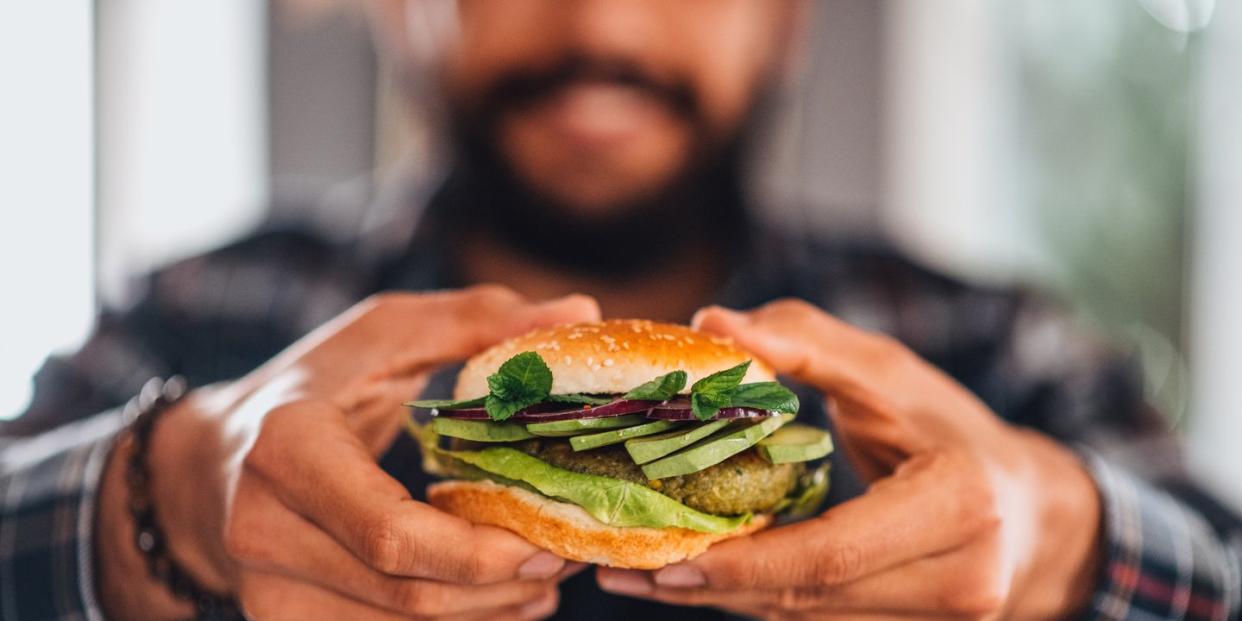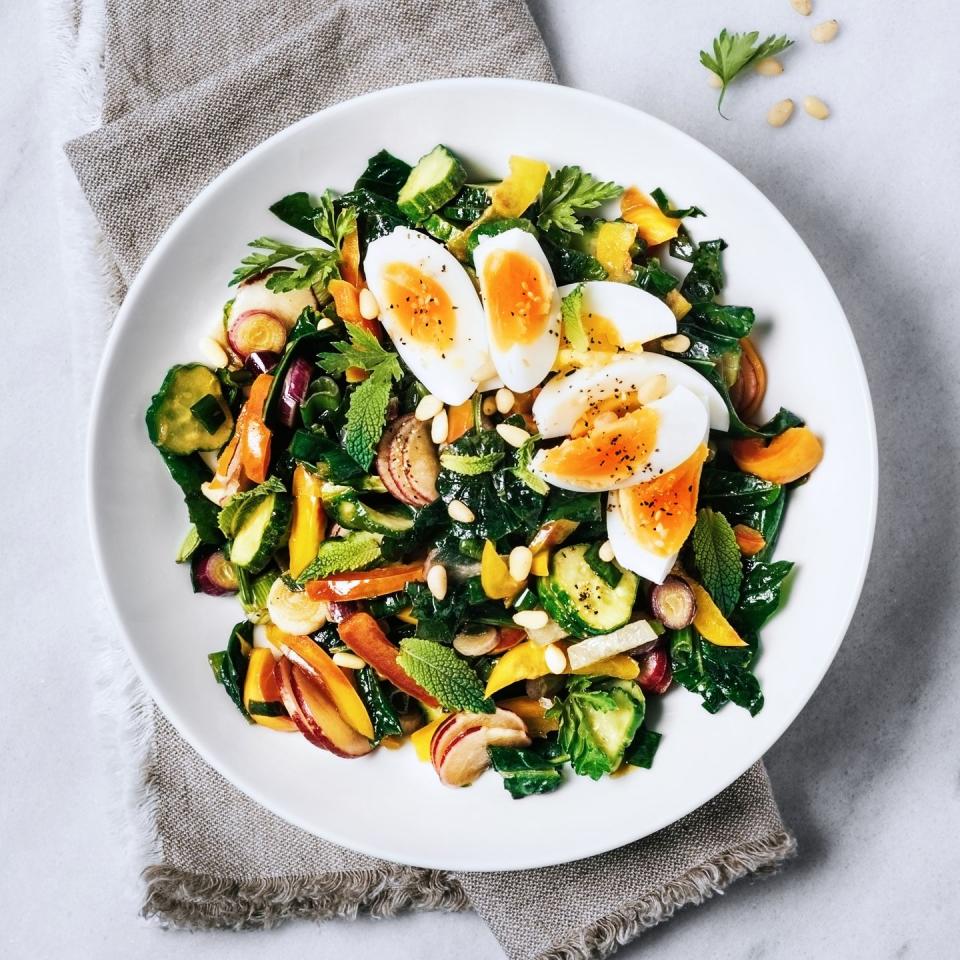This Plant-Based Diet Still Lets You Have Meat

"Hearst Magazines and Yahoo may earn commission or revenue on some items through the links below."
The flexitarian diet is ahead of its time. The concept became popular after Dawn Jackson Blatner, R.D., published The Flexitarian Diet in 2008, and is essentially an outline of the type of plant-based eating (mostly plants, but a little meat every now and then) that’s become incredibly trendy in the past few years.
Unlike other trendy plans, the flexitarian diet isn’t an unsustainable fad. In fact, the whole point of the flexitarian diet is that it’s a way to eat in a nutritious, plant-forward way without having to swear off meat forever.
And if you’re wondering if flexitarian is worth it, the answer is a resounding yes. The evidence in support of following a plant-based diet is pretty convincing, even when there’s still a little bit of meat involved. Flexitarian diets can improve metabolic health, lower blood pressure, and reduce your risk of diabetes. Some research also suggests that flexitarian diets that reduce animal consumption by two-thirds could actually have a lower climate footprint than traditional vegetarian (but not vegan) diets. In other words, the flexitarian diet makes it possible to have your steak and eat it, too.
As the name implies, this crowd generally eats vegetarian but aren't sticklers. Many meals will be vegetarian and plant-based protein sources have a starring role, but meat isn’t completely off the table. You can get creative with grain bowls, tofu stir-fries, and bean-based stews, but you can also go ahead and order a burger when the craving hits.
Sound tempting? Here's a look at whether it's right for you.
What is the flexitarian diet?
Blatner popularized the term “flexitarian” in 2008, and these days it’s even trendier thanks to mounting research supporting plant-based eating. The term even nabbed a spot in Merriam Webster, which defines flexitarian as someone whose "normally meatless diet occasionally includes meat or fish."
According to Blatner, she coined the term because consuming meat induced guilt since she was a practicing vegetarian.
"I developed this style of eating for people who know that vegetarianism is one of the healthiest and smartest ways to eat, but don’t want to sit in the corner at a BBQ with an empty bun," she writes on her blog.
Blatner's plan is separated into three stages, depending on your current meat consumption: beginner, advanced, and expert.
If you you can't even fathom one-meat free meal each day, you'll want to start at the first stage. However, those who already limit meat consumption can jump into advanced.
How much meat can you eat on the flexitarian diet?
Generally, you'll want to structure meals depending on your level:
Beginner
Aim to eat about 26 ounces of meat or poultry per week and 2 meatless days.
Advanced
Aim for 18 ounces of meat or poultry per week and 3 to 4 meatless days.
Expert
Aim for 9 ounces of meat or poultry per week and 5 meatless days.
Beginner level seem overwhelming? Build up to it, suggests Holly Herrington, R.D. at Northwestern Memorial Hospital.
"Start with one to two meals [per week]," she says. "Then three meals, and then one whole day."
What are the benefits of a flexitarian diet?
It's not restrictive
"I love this diet because I think what makes it so appealing is how doable it is," says Herrington. There's no need to give up wings, burgers, or any other food that you love.
"It’s more of a push towards getting fruits and vegetables in," she says.
Other experts agree. Toby Smithson, R.D. founder of DiabetesEveryDay.com and author of Diabetes Meal Planning and Nutrition for Dummies, says that the flexitarian diet is an excellent roadmap for those trying to cut back on meat but not sure where to start. She loves that the book includes recipes and food combination ideas, without being overly restrictive.
“Having flexibility is key to sustaining an eating plan,” Smithson says.

It's vitamin and fiber-rich
Provided that meat is replaced with produce, instead of say, potato chips, you'll receive a good variety of vitamins and minerals, says Herrington. Guys should get about 35 grams of fiber each day, but studies show only five percent of Americans eat enough of the nutrient.
Aside from the obvious, like regular bowel movements, fiber helps lower cholesterol, decreases the risk of heart issues, and can keep you full for longer.
It may help you lose weight
Flexitarian diets are linked to a reduced risk of type 2 diabetes and lower body weight, according to a 2016 review of studies published in the journal Frontiers in Nutrition.
As with any diet, losing weight comes down to what and how much you're eating. Eating a whole cheese pizza instead of chicken isn't going to help shed extra pounds. And it's entirely possible to overdo it on healthy foods like avocados.
"You can still get way too many calories from healthy foods," says Herrington. Take nuts, for example. A serving of almonds 23 nuts, but it's easy to eat double that if you don't measure out a single portion.
"I don't know a lot of people who eat 23 almonds and are like, 'Oh i’m so full,'" says Herrington, "It’s about being mindful of your portions and overall healthy food choices. It’s not just about cutting out meat."
It's good for your heart
A 2020 study published in the British Journal of Nutrition surveyed 10,797 Swiss adults and found that those who followed any kind of meat-reducing diet (vegetarian, pescatarian, or flexitarian), were likely to have lower cholesterol and blood pressure, both of which lead to a reduced risk of heart disease.
These heart-healthy benefits are due to various characteristics of the flexitarian diet, including more fiber, less saturated fat, and less dietary cholesterol, Smothson says.
A sample flexitarian meal plan
There's no need to worry about subsisting on tofu and salads. A typical flexitarian breakfast could include Greek yogurt with berries and peanut butter toast, eggs with vegetables, or yes, a tofu scramble. Whole-wheat pasta or veggie burgers make easy meat-free lunches, and vegetable stir-fry are great weeknight dinners.
Dedicate half of your plate to vegetables. Then, designate one-third each to protein and starches.
How to start eating a flexitarian diet
Before diving in, look at how many meals include meat each week. Then, develop a plan to slowly decrease consumption, advises Nathalie Sessions, R.D. at Houston Methodist Hospital. Herrington suggests starting with plant-based meal a week if you consume meat for breakfast, lunch, and dinner. Paying attention to portion sizes will ensure you're not overeating while helping you pack in enough fruits and vegetables.
You Might Also Like

